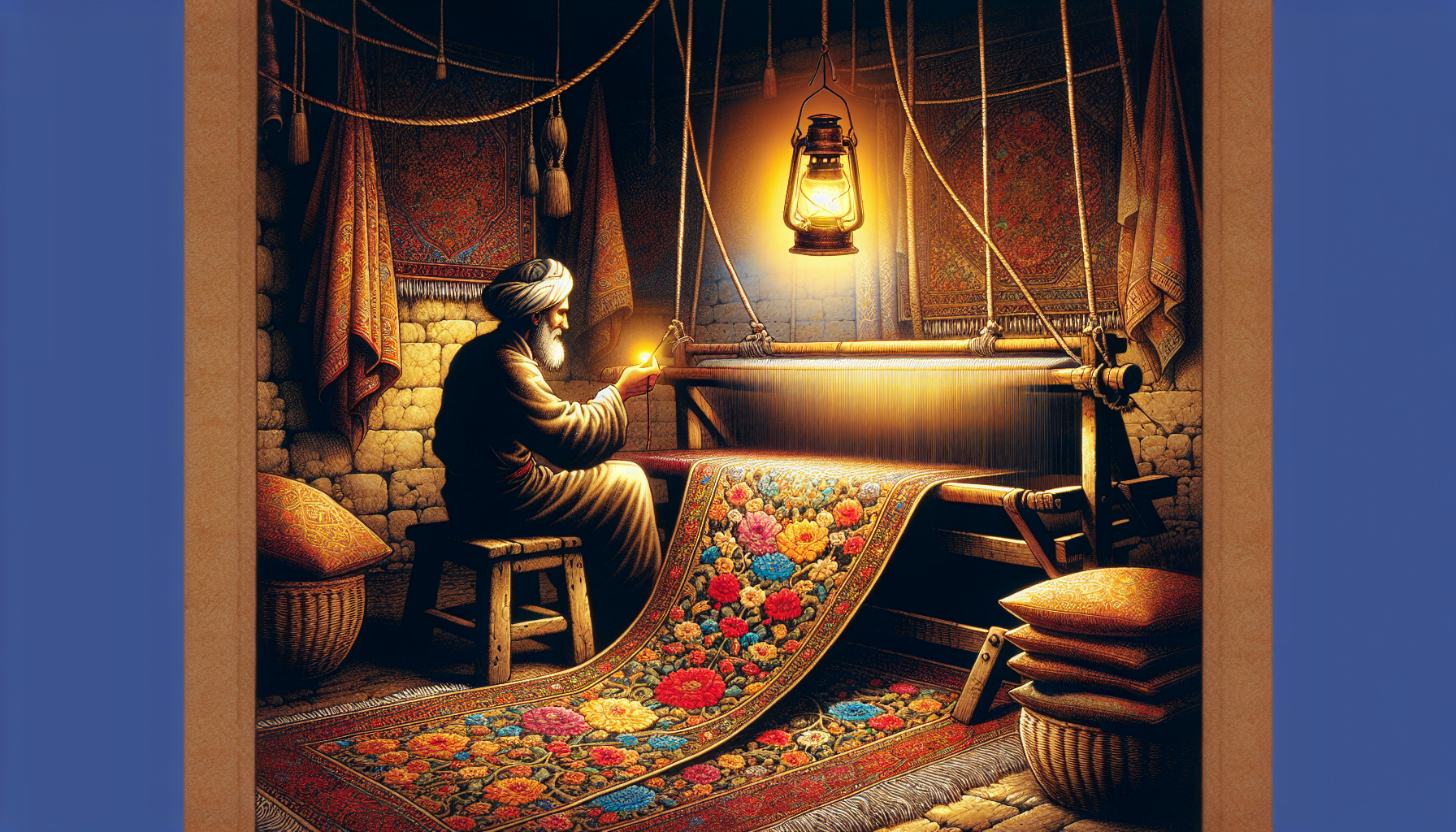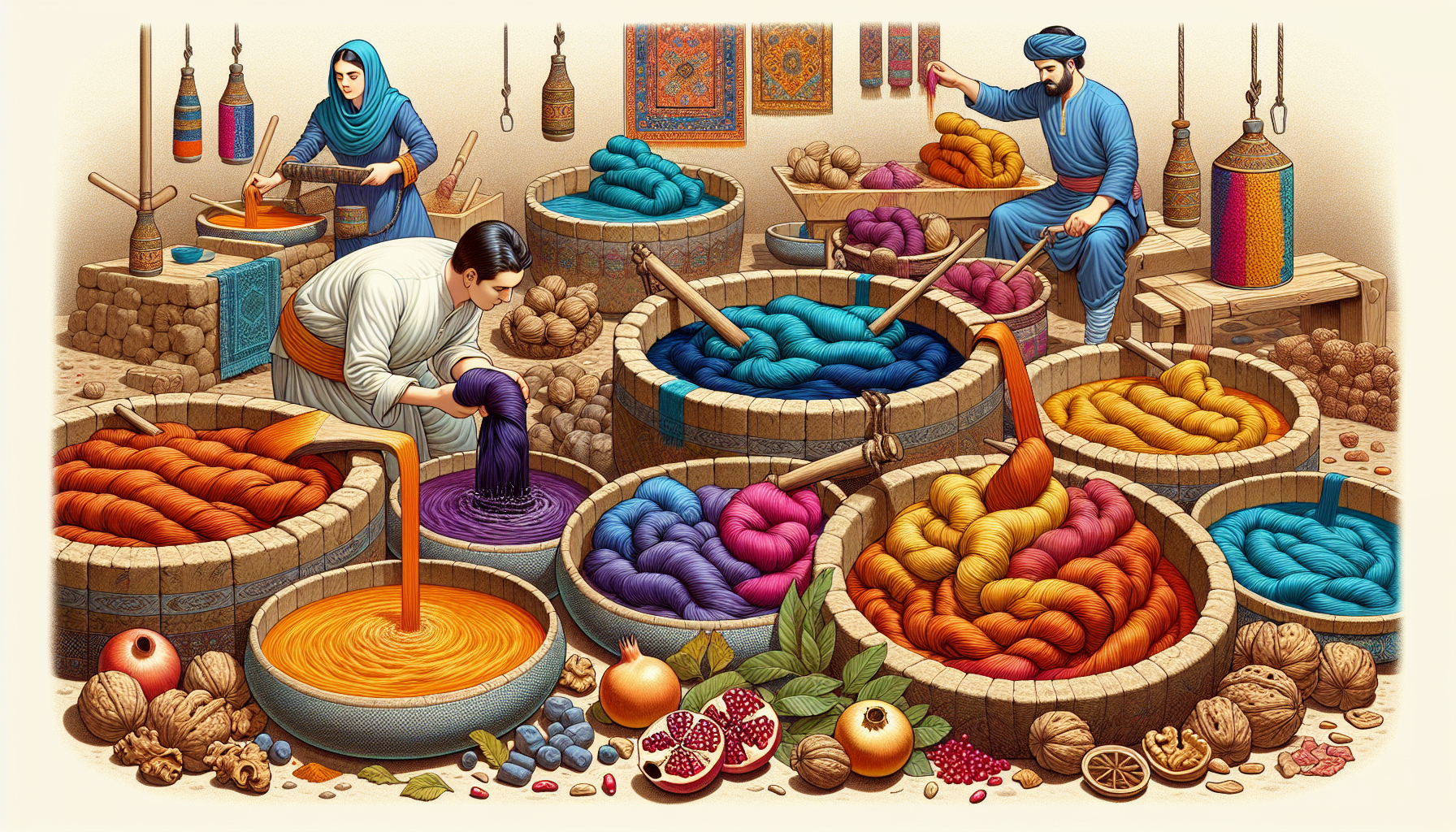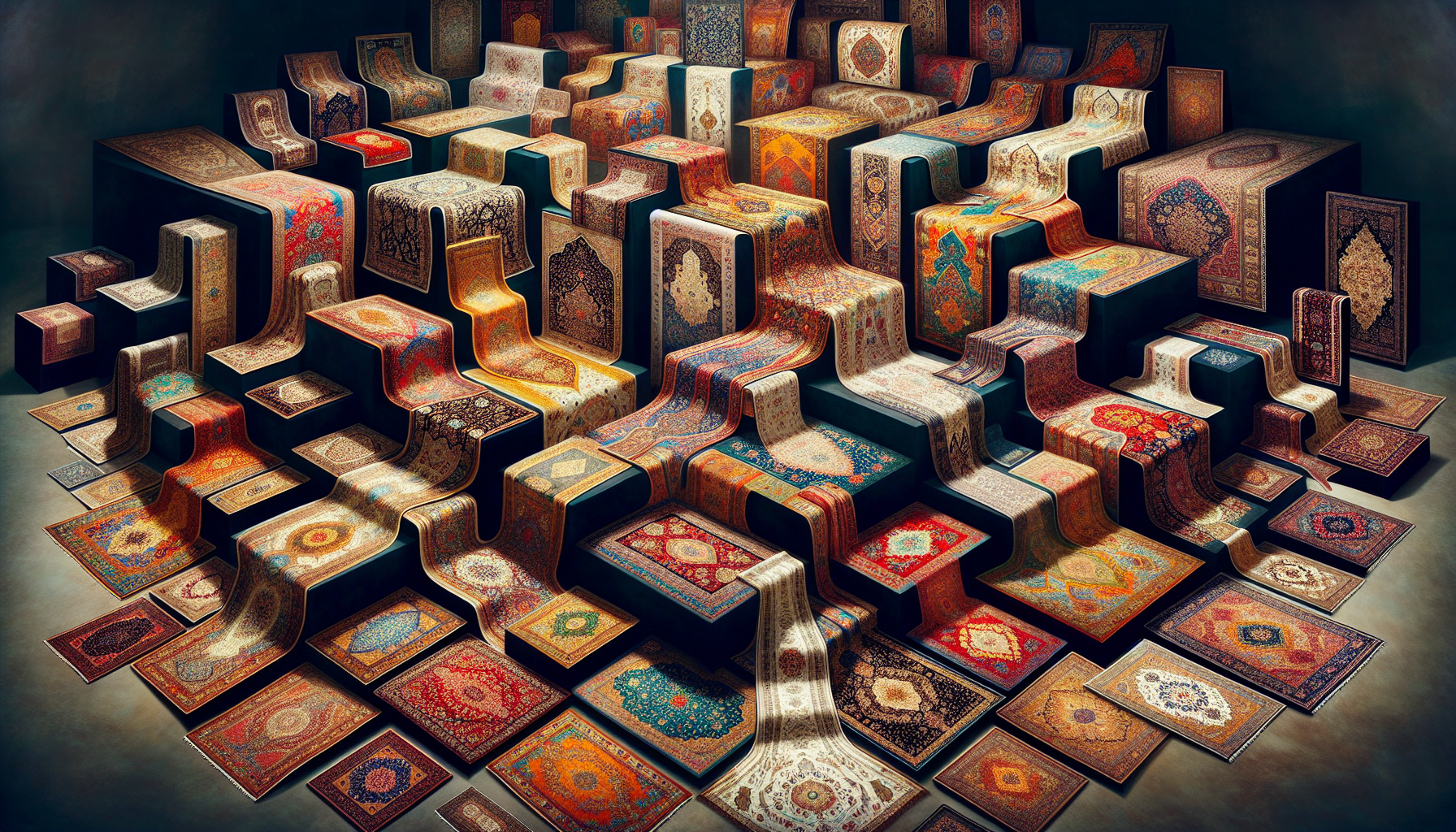Why are Persian rugs so expensive? These opulent floor coverings command high prices due to a blend of skilled craftsmanship, premium materials, and a deep cultural legacy. In this article, we explore the artistry, materials, and exclusivity that contribute to their cost, offering insight into the enduring value and appeal of Persian rugs.
Jump to section
Key Takeaways
Persian rugs are highly valued due to their intricate hand-knotting process by skilled artisans, cultural narratives, and labor-intensive creation, making each rug a unique masterpiece of Persian culture.
The choice of high-quality materials like wool, silk, and natural dyes, along with regional variations in design and craftsmanship, adds to the luxury, sustainability, and distinctive appeal of Persian rugs.
Factors such as knot density, rarity, exclusive craftsmanship, geopolitical restrictions, investment potential, provenance, and proper care contribute to the high price, appreciating value, and longevity of Persian rugs.
The Artistry Behind Persian Rugs: Time and Skill

Creating a Persian rug is akin to orchestrating a symphony; each knot stands for a note, each design resembles a melody, and each hand knotted rug manifests a masterpiece. The hand-knotting process is painstaking, requiring significant physical and mental endurance from skilled artisans. These artisans undergo years of apprenticeship, mastering the intricate technique of small, densely packed knots, which contribute to the durability and intricate design of hand knotted rugs.
Each Persian rug weaves a narrative of cultural heritage, encapsulating the diverse artisan traditions that span across Iran. The weavers follow complex patterns and motifs, often relying on memory to create the intricate Persian rug designs that adorn these rugs. This level of craftsmanship in carpet weaving is a testament to their skill and dedication, and it’s what makes the Persian rug industry truly remarkable.
The blend of cultural significance, meticulous craftsmanship, and labor-intensive creation process augments the aesthetic allure and intrinsic value of Persian rugs. Each rug holds within its threads a piece of Persian culture, a testament to the country’s rich history, and the skill of its artisans.
The Role of Materials: Wool, Silk, and Natural Dyes

In the realm of Persian rugs, the selection of materials is of pivotal importance. Wool, for instance, is the most common and preferred material due to its durability and soft texture. Its natural lanolin improves stain resistance and contributes to the longevity of the rugs.
Silk, on the other hand, adds a luxurious element to Persian rugs, especially silk rugs. Its softness, shine, and rarity enhance the rug’s appeal. However, it is more costly due to the extensive labor required to harvest and process silkworm silk.
Lastly, natural dyes extracted from plants, roots, and insects not only imbue Persian rugs with vibrancy but also bear witness to the premium craftsmanship and time-honored dyeing techniques. The use of these high-quality natural materials enhances the value, sustainability, and luxurious feel of Persian rugs.
Regional Distinctions: A Reflection of Iran’s Cultural Diversity

The diversity of Persian rugs mirrors the cultural richness of their homeland. Each region of Iran has its unique styles, designs, and weaving techniques, which reflect through the rugs they produce. For instance:
Small Balouchi rugs showcase dark blue or red geometric patterns
Vibrant Zanjan rugs carry tribal designs
Rustic Malayer rugs feature traditional motifs
Renowned weaving centers like Tabriz, Isfahan, and Kashan contribute to the exclusivity and value of Persian rugs. These regions, including those producing Isfahan rugs, offer highly sought-after features such as:
Fine craftsmanship
Diverse designs
Exquisite floral patterns
Intricate medallion designs
These designs vary from region to region, reflecting their rich history and cultural significance.
The presence of traditional designs and motifs on authentic Persian rugs, which remain less influenced by Western consumer demands, serve as a hallmark of authentic craftsmanship. They represent the cultural heritage embedded within these artisanal creations.
Knot Density and Complexity: A Measure of Quality
In the realm of Persian rugs, the metric for quality is knots. A higher knot density is indicative of superior craftsmanship and the ability to achieve more detailed designs. The knot density can range from about 25 knots per square inch in nomadic rugs to over 1,000 knots per square inch in finely crafted workshop rugs. This demonstrates varied levels of complexity and skill.
A high knot count, such as over one million knots per square meter, underscores an exceptional level of skill and experience in rug making. This directly impacts the rug’s intricacy and aesthetic value, making each piece a work of art. Hand-knotted Persian rugs, often featuring a dense feel and visible knots on the backside, are considered of higher quality than machine-made rugs.
Rarity and Exclusivity: Limited Supply and High Demand
The scarcity of Persian rugs derives not only from their exquisite craftsmanship. Geopolitical issues and sanctions on Iran significantly limit the international availability of genuine Persian rugs, adding to their exclusivity. This rarity is exacerbated by urbanization and the reduction in the number of skilled rug weavers in Iran.
Unusual motifs, especially those depicting animals or historical events, are particularly valuable as collector’s items. Owning a Persian rug is like owning a piece of history, a unique artifact that tells a story of a time and place long gone.
Investment Potential: Appreciating Assets
Persian rugs transcend mere decorative elements; they represent appreciating assets. Take, for instance, a 17th-century Persian vase carpet that fetched $33.8 million at an auction in 2013, exemplifying the considerable investment potential of these items. The aging process of Persian rugs, alongside their maintenance in prime condition, plays a critical role in their rising valuation over time.
Each Persian rug’s distinctive handcrafted nature enhances its value, making it not only a functional item but a unique art piece likely to appreciate over time. Geopolitical complexities and sanctions restrict the supply of Persian rugs, indirectly boosting their desirability and making them more valuable as investment assets.
Global cultural appreciation elevates the demand for Persian rugs, with collectors worldwide willing to pay a premium for their authenticity. This contributes to their investment allure. Persian rugs offer long-term investment appeal by serving as heirlooms that can be passed down generations, growing in historical and emotional value over time.
Beyond their considerable monetary value, Persian and oriental rugs, also known as Persian rugs, oriental rugs, or Persian carpets, are highly collectible for their intricate designs, rich symbolism, and historical significance.
Provenance and Authenticity: Factors That Influence Value
The worth of a Persian rug extends beyond its craftsmanship or materials. The provenance or documented history of a rug, including its origin and previous ownership, can substantially increase its value. The age of a Persian rug can also contribute to its value. Older rugs are sought after for their maturity, natural sheen, and the patina developed over time.
Rugs that feature rare and unique designs, particularly those from famous workshops or tribes that no longer exist, are highly valuable. Antique rugs, like these tribal rugs, are like pieces of a puzzle that tell a story of a bygone era, making each rug a precious relic of history. Handmade rugs, especially antique ones, showcase the craftsmanship and artistry of their creators.
Caring for Your Persian Rug: Tips for Preservation
The upkeep of a Persian rug entails more than mere spill prevention. Regular vacuuming using the correct settings prevents damage to the rug fibers and maintains its appearance. Periodically rotating the rug helps distribute wear and fading, preserving the rug’s integrity, especially in high-traffic areas or under direct sunlight.
Placing padding under Persian rugs, a popular choice of floor coverings, can prevent shape distortion, protect against debris, reduce wrinkling, and enhance safety on smooth floors. Using window treatments or changing the rug’s location prevents excessive fading and fiber weakening from prolonged exposure to sunlight.
To prevent moisture problems, which can cause mildew, mold, or shrinkage, rugs should be aired out periodically in a dry environment. Occasional deep cleaning by professional rug cleaners is advisable to prolong the rug’s lifespan and invigorate its appearance. Proper maintenance contributes to a Persian rug’s longevity, with well-preserved rugs potentially lasting over 200 years, thereby maintaining or enhancing their investment value.
Identifying Quality: A Guide to Choosing the Right Persian Rug
In the selection of the ideal Persian rug, uncompromised quality is of utmost importance. Examining a rug’s knot density by feeling the softness and observing imperfections on the back of the rug can indicate its quality and authenticity.
A Persian rug’s uniqueness and quality are further enhanced by the use of rare colors, natural materials, and diverse designs. Each rug tells a different story, and finding the one that speaks to you is part of the joy of owning a Persian rug.
Summary
From the intricate artistry and high-quality materials to the cultural significance and investment potential, it’s clear that Persian rugs are more than just floor coverings. They are a testament to a rich history, a showcase of exquisite craftsmanship, and an embodiment of cultural diversity. Their high price tag is a reflection of their value, rarity, and the painstaking process that goes into creating each piece.
As we wrap up this exploration, remember that each Persian rug is a piece of art, a slice of history, and a symbol of cultural heritage. Owning one is not just a purchase but an investment, a commitment to preservation, and a step into a world of beauty, history, and craftsmanship.
Frequently Asked Questions
What is special about Persian rugs?
Persian rugs are known for their durability and longevity, as they can last for decades or even centuries, making them valuable family heirlooms due to the quality materials and craftsmanship.
What makes Persian rugs so expensive?
The high cost of Persian rugs can be attributed to factors such as the time and skill involved in their creation, the use of high-quality natural materials, their cultural significance, and their potential as an investment. These factors contribute to their overall expense.
How can I identify a high-quality Persian rug?
You can identify a high-quality Persian rug by examining the knot density, materials used, design uniqueness, provenance, and age. Consider these factors to assess the rug’s quality.
Why are Persian rugs considered good investments?
Persian rugs are considered good investments because they appreciate in value over time, are rare and collectible, and their supply is limited due to geopolitical issues. This makes them valuable assets for the long term.
How can I take care of my Persian rug?
To take care of your Persian rug, regularly vacuum it, rotate it periodically, and have it professionally cleaned occasionally to maintain its longevity and value.